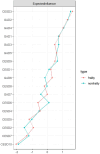The relationship between frailty in older adults and anxiety and depression in china: propensity score matching and network analysis
- PMID: 40809861
- PMCID: PMC12345367
- DOI: 10.3389/fpsyt.2025.1596015
The relationship between frailty in older adults and anxiety and depression in china: propensity score matching and network analysis
Abstract
Objective: Anxiety and depression are common mental disorders in the elderly. Concurrent frailty may lead to worse clinical outcomes. This study examined the network structures of anxiety and depression in frail and non-frail older adults.
Methods: The Center for Epidemiologic Studies Depression Scale-10 (CESD-10) and the Generalized Anxiety Disorder Scale-7 (GAD-7) were used to measure depressive and anxiety symptoms, respectively. Following propensity score matching (PSM), 877 frail elderly individuals were matched with 877 non-frail elderly individuals. Central (influential) and bridge symptoms were estimated using the expected influence (EI) and bridge expected influence (bridge EI), respectively. Network stability was assessed using the case-dropping bootstrap method.
Results: Based on the NCT results, there were no significant differences in the comparison of the network models between the non-frailty group and the frailty group in terms of global strength (7.175 vs. 7.136, S = 0.039, P = 0.802) and network structure (M = 0.137, P = 0.703). There were also no significant differences in edge weights between the networks of the two groups (P > 0.05).
Conclusion: NCT results showed no significant difference in the network structure of anxiety and depression between frail elderly and control groups. A slight decrease in network strength was observed in non-frail elderly but was not statistically significant. Both groups showed similar characteristics in bridging symptoms, central symptoms, overall strength, and network structure. Interventions for anxiety and depression are equally beneficial for both frail and non-frail elderly.
Keywords: anxiety; depression; frailty; network analysis; older adults.
Copyright © 2025 Li, Zhao, Lin, Wang, Zhang, Zhou and Cai.
Conflict of interest statement
The authors declare that the research was conducted in the absence of any commercial or financial relationships that could be construed as a potential conflict of interest.
Figures
Similar articles
-
Oral nutritional interventions in frail older people who are malnourished or at risk of malnutrition: a systematic review.Health Technol Assess. 2022 Dec;26(51):1-112. doi: 10.3310/CCQF1608. Health Technol Assess. 2022. PMID: 36541454 Free PMC article.
-
Relationships between physical frailty, depressive symptoms, and cognitive ability among community-dwelling older adults in India.BMC Public Health. 2025 Jul 2;25(1):2183. doi: 10.1186/s12889-025-23197-y. BMC Public Health. 2025. PMID: 40604490 Free PMC article.
-
Physical exercise training interventions for children and young adults during and after treatment for childhood cancer.Cochrane Database Syst Rev. 2016 Mar 31;3(3):CD008796. doi: 10.1002/14651858.CD008796.pub3. Cochrane Database Syst Rev. 2016. PMID: 27030386 Free PMC article.
-
Prescription of Controlled Substances: Benefits and Risks.2025 Jul 6. In: StatPearls [Internet]. Treasure Island (FL): StatPearls Publishing; 2025 Jan–. 2025 Jul 6. In: StatPearls [Internet]. Treasure Island (FL): StatPearls Publishing; 2025 Jan–. PMID: 30726003 Free Books & Documents.
-
Investigation and analysis of mental health status of the older adult in western rural areas.Front Public Health. 2025 Jul 16;13:1612600. doi: 10.3389/fpubh.2025.1612600. eCollection 2025. Front Public Health. 2025. PMID: 40740371 Free PMC article.
References
-
- Ma W. ulletin on the Development of National Aging Affairs in 2022 - Departmental Updates - The People’s Government of the People’s Republic of China [WWW document] (2022). Available online at: https://www.gov.cn/lianbo/bumen/202312/content_6920261.htm (Accessed 11.12.24).
LinkOut - more resources
Full Text Sources
Miscellaneous




